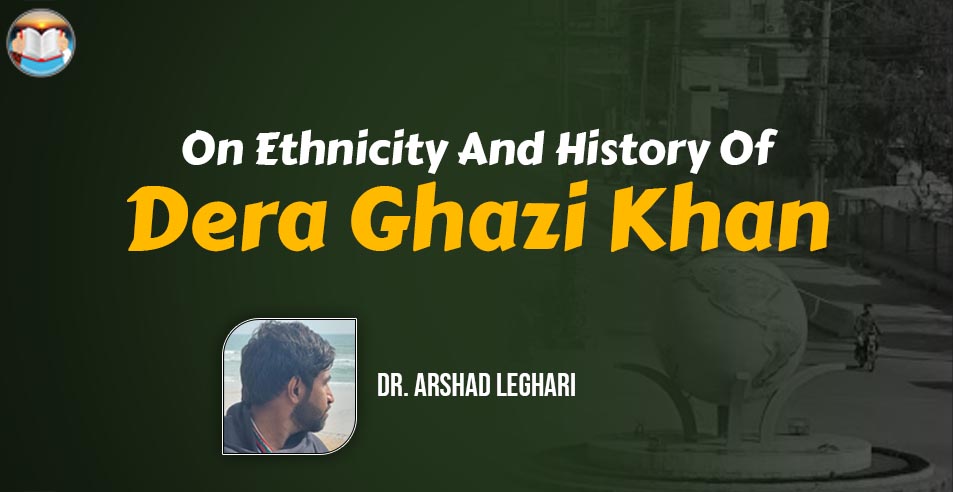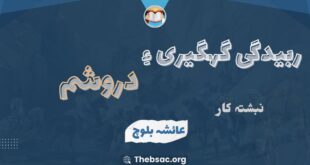On Ethnicity And History Of Dera Ghazi Khan
Dr Arshad Leghari
Dera Ghazi Khan now administratively a district of Punjab province of Pakistan is a city located at Western bank of Indus River. Dera Ghazi Khan is surrounded by mountains of Koh E Suleman in the west, touches Dera Ismalil Khan in the North and in South is in contact with Kishmore (a Baloch majority city now a part of Sindh) through Rajan Pur, which is itself now a District of Punjab. It consists of major towns of Taunsa Sharif , Dera Ghazi Khan and Kot Chuta. The urban areas of Taunsa Sharif and Dera Ghazi Khan are densely populated, with hundreds of suburban and rural settlements. Jampur , Fazal Pur ,Rojhan and Rajan Pur are major towns of Rajan Pur. Hills of Madi, Fort Munro , Yakbi and Beho are located in the west. According to latest consensus population of Dera Ghazi Khan and Rajan Pur are 3 millions and 2 millions respectively.
Topography of Dera Ghazi Khan
Topographically Dera Ghazi Khan is divided in to 3 parts.
- Koh E Suleman mountains range consisting of mighty hills and plateaus forms about 52 percent of total land of Dera Ghazi Khan. Tribal areas of Dera Ghazi Khan and Rajan Pur are located in this range. Major tamuns of the area are Kaisrani ,Buzdar ,Lound,Khosagh, Legahri, Gorshani and Mazari, last two now considered as parts of Rajan Pur. This area touches to tamun Khetran , Bugti and Marri in the west. Balochi is the native language here
- Banni / Damaan is an extension of Koh E Suleman range which is low land with occasional peaks. This area has many Baloch towns where both Siraiki and Balochi are spoken and understood.
- Kachi / Bait is the bank of River indus. This is mostly fertile agricultural land that is occupied by Baloch Landlords with both Siraiki and Balochi as their languages.
History Of Dera Ghazi Khan
History of modern Dera Ghazi Khan backs to 15th century. It was a time when Koh E Suleman mountains were the home of Baloch Tribes, Daman and Kachi being the grazing fields for their cattle. A few towns like Hadand,Choti Bala Mangrotha and Asani existed.
The history of modern Dera Ghazi Khan can be divided in to 5 periods for the convenience of readers.
1.Dodai Dynasty
2. Kalhoda Dynsaty
3. Sikh Period
4. English Period
5.Formation of Pakistan and Post Pakistan Period
1.Dodai Dynasty
Multan was occupied by Langahs in the mid of 15th century, then they being rulers of Sibbi. They governed Multan from 1445 to 1526. Qutb Ud Deen Langah the first Langah was followed by Hussain Langah. To strong-arm his Western front Hussain Langah invited Dodai Baloch to settle on the west bank of River Indus. Mir Fateh Khan Dodai and Mir Sohrab Khan Dodai were the first Dodai notables to Inhabit these lands in the west of River Indus. Dera Ghazi Khan City was founded by Mir Haji Khan Mirani in 1469 who named it as Dera Ghazi Khan after his son Ghazi Khan. Mirani Baloch ( Dodais) ruled Dera Ghazi Khan for 15 generations for more than 250 year.
After Langah’s fall in 1526, Baloch moved and conquered a lot of areas in the east of River Sindh, founding the cities of Layyah , Kot sultan ,Fateh Pur and Kot Adu. During this period Baloch of Dera Ghazi Khan prospered. Miranis built new canals , improvised central tax systems and revenue. They traded directly with Sindh, Iran and Afghanistan. At a time Mirani Saltnat extended from Ouch in the South to Dera Ismail Khan and Layyah in the North. Miranis enjoyed full sovereignty during most of their time they ruled, never paid any homage to Delhi or any other emperor.
During years of Mughal King Akbar , Mughal influence started to increase in Baloch Dera Jat. In the later years of Aurangzeb, round about the 1700s ,Moj Ud Din then Governor of Multan attacked Dera Ghazi Khan and brought Dera Jaat under Mughal umbrella after a lot of hard work.
2.Kalhoda Dynasty
During earlier years of 18th century Kalhodas started having influence in the Sindh. Kalhodas defeated Governor of Sibbi with aid of Khan Of Kalat. Yar Muhammad Kalhoda became Governor of Sibbi, accepted the supermacy of Emperor of Delhi and settled in Sindh. Noor Muhammad Kalhoda son of Yar Muhammad Kalhoda marched towards North and defeated Mirani Baloch of Dera Jaat. Main time Nadir Shah got influence over western bank of River Indus. Noor Muhammad Kalhoda paid a handsome amount of homage to Nadir Shah. Mahmood Khan Gujar was appointed as Governor of Dera Ghazi Khan . Mahmood Khan Gujar arrested last Mirani Khan , who died in Hyder Abad later. Mahmood Khan Gujar was followed by his nephew who was killed in 1779. After that Governors of Dera Ghazi Khan came directly from Afghanistan. During this period lawlessness spread across Dera Jat, Canal system collapsed. Baloch of Dera Ghazi Khan reorganised themselves and became independent of any foreign influence.
In the south Sheikh Rajan got better of Nahads and formed city of Rajanpur. Mazaris from Kohistan stormed and shattered the grip of Sheikh. Later the eastern parts of Sheikh’s Government came under Nawab of Bahawalpur and western areas to Governor of Afghanistan.
Towns of Dajal and Hadand were handed over to Khan of Kalat by Duranis in 1758. These two towns remained under Khan’s influence till 1827.
3.Sikh Period
Ranjit Singh attacked and conquered parts of Dera Ghazi Khan between 1819 to 1821. Sikhs handed over Sanghad to Nawab of Bahawalpur through a deal. Later in 1827 Nawab of Bahawalpur also got power over Dajal and Hadand, which were under direct Government of Khan Of Kalat . The deal between Khan of Bahawalpur and Sikhs broke in 1830. General Dantora (later Dewan Sawan Mall) became governor of Dera Ghazi Khan. Dewan Sawan Mal marched with 7000 men towards South to have Mazaris under grip. Mazaris fought and fled back to Kohistan. They regrouped and tried again and occupied Mithan Kot. Dewan Sawan Mal once again attacked Mazaris and arrested Mir Behram Khan Mazari and presented him to Sikh Court. After Dewan Sawan Mal his son Mol Raj became the governor.
Sikh Period is filled with resistance and struggle of Baloch Tribes against them. Ballads of battles against Sikhs still resonate among the Baloch of Dera Ghazi Khan.
4.English Period
During 1840s Robert Edwards was given task to occupy Dera Ghazi Khan who was working at land reforms in Dera Ismael Khan at that time. Robert Edwards ordered General Court land to conquer Dera Ghazi Khan. Sardar Ghulam Haider Khosa and Lound Sardar of Souri Lound stood with English. Sardar Asad Nutkani and Sardar Jalal Khan leghari helped Sikhs. Koda Khan Kaisrani for his 15 men killed 140 personal of Sikh Raaj , Sardar Asad Nutkani and Sardar Jalal Khan leghari. Chetan who was assistant of Mol Raj was thrown out by English from Mangrotha. Sikh representative of Killa Hadand could not stand against English officers and fled. Englishmen occupied the lowlands of Dera Ghazi Khan by 1849, but they could not get mountain range under their influence till 1887. General Court Land became first deputy commissioner of Dera Ghazi Khan. Dera Jaat was formed consisting of Dera Ismail Khan, Bannu in the North and Dera Ghazi Khan and Rajan Pur in the South.
Like other parts of Balochistan English came across with fierce resistance from Baloch of Dera Ghazi Khan. Among these wars War Of Han Band ( Tamun Buzdar) is prominent in which commissioned officers of English Army were killed. In another incident whole village of Bathi ( Tamun Kaisrani) was set ablaze to overcome Kaisrani Resistance. According to some sources Ghulam Hussaun Masori also had support of Sardar Jamal Khan Leghari.
British Balochistan consisting of Pakhtoon areas and Baloch areas of North East was formed by English Sarkar in 1877. Marri Bugti Baloch areas were handed over to AGG British Balochistan Robert Sandeman, while Eastern part of Baloch Land consisting of Koh e suleman, Daman and Kachi of Dera Ghazi Khan remained under Punjab Government. It is to be noted here that Robert Sandeman demanded English Governments to have Deputy Commissioner of Dera Ghazi Khan under his authority, but was rejected and the Baloch areas of Dera Ghazi Khan became a part of Punjab. Inayat Ullah Baloch in his book Problem Of Greater Balochistan says that multiple attempts on part of Robert Sandeman and his follower were made to convince English government to make Dera Ghazi Khan and Rajan Pur parts of Balochistan, but in vain. English colonisers sticked to the policy of divide and rule.
In 1901 North Westren Frontier Province was made , Dera Ismail Khan and Bannu parts of Dera Jat then, were made part of the new province.
On 27th November 1946 Nawab Akbar Bugti , Sardar Doda Khan Marri and Sardar Jamal Khan leghari met representatives of English government and requested them to merge tribal areas of Dera Ghazi Khan ,Rajan Pur and Marri Bugti areas with the government of Khan Of Kalat.
Notables of Dera Ghazi Khan also participated in All Baloch Conference of Jacob Abad in 1931.
4.Formation Of Pakistan and Post Pakistan Period
Subcontinent was divided on August 14_15th of 1947. Two independent states Pakistan and India were formed. On August 15 1947 , Muhammad Ali Jinnah, Governer General of Pakistan issued an official order which he stated that’ the legal status of tribal areas of Dera Ghazi Khan, Rajan Pur and Marri Bugtis will remain as it was, until the people decide for themselves. Governer Punjab would be responsible for tribal areas of Dera Ghazi Khan and Rajan Pur while AGG Balochistan for Marri Bugti areas.
On March 1 , 1949 a meeting was held under presidency of Francis Moodi Governor General of Punjab, in which Tamun Daars, Jirga members and other notables participated. In this meeting this was decided that tribal areas of Dera Ghazi Khan and Rajan Pur will be part of Balochistan. Later through threats, offer of land allotment to the Tamun Dars and blackmailing through Central Legislation Assembly Laws, these areas were made part of Punjab on the basis that, Government Of Punjab will not intervene in the internal laws and affairs of region. So ,the Baloch tribal area of Dera Ghazi Khan were made part of Punjab in 1950 after all. The remembrance signboard is still present at the top of Fort Munro, which has names of All Tamun Daars , Political Assitan Dera Ghazi Khan , Deputy Commissioner Dera Ghazi Khan and Multan and other administrative members of Dera Ghazi Khan and RajanPur.
Nawab Ahmad Yar Khan met General Sikandar Mirza in 1957 in which he was accompanied by Nawab Jamal Khan Leghari as representative of Baloch of Dera Ghazi Khan.
In 1982 District of Rajan Pur was made comprising of Jampur, Rajan Pur and Rojhan.
The tribal areas of Dera Ghazi Khan and Rajanpur are still under the political assistant. Before Pakistan tribal areas had FCR. After merging in to Pakistan specific laws were made . These areas did not come under Punjab High Court until 1993.
Our Stance
Once someone asked Noori Naseer Khan “ What are the boundaries of Balochistan “, he replied ”wherever Baloch live is Balochistan”. Dera Ghazi Khan is historically a Baloch majority region for about centuries. The Miranis and ruled Dera Ghazi Khan for about 250 years. Buzdars , Kaisarani, Khetrans , Nutkanis, Lound, Khosaghs, Legharis ,Gorshanis, Dreshaks and Mazaris have been inhabitant of this land for hundreds of years.
Geographically west of River Indus is not considered to be a part of Indian Subcontinent by most of the experts of Geography. The land structure of Dera Ghazi Khan and Koh E Suleman shows us a typical Eastern Baluchistan rather then South Punjab or Bahawalpur.
Baloch cultural values ,norms and ethics are equally resonant among the Baloch of Koh E Suleman , Damaan and Bait. Baloch national heroes still are alive in the streets, lands and mountains of Dera Ghazi Khan. Ballads of resistance ,love and tragedy are still remembered at heart by Baloch of Dera Ghazi Khan.
As Dera Ghazi Khan touches in the North to Dera Ismail Khan so Pashto is commonly spoken and understood here. We are connected to Sindh through Rajan Pur in South so Balochs of Rajan Pur also have grip over Sindhi. Bridges have been built, modren communication has connected the Baloch of Dera Ghazi Khan , Rajan Pur,Muzaffar Garh and Kot Adu to Mutan and Bahawalpur so both Siraiki and Balochi are spoken and understood in the eastren parts of Dera Ghazi Khan and Rajan Pur.
The major Ethnicity of Dera Ghazi Khan, till today is Baloch with Balochi and Siraiki being our languages. It should be noted that Siraiki is also spoken as a language in other parts of Baloch Land including Sibbi , Naseer Abad and Jacob Abad. The very fact that Siraiki is spoken and Understood as a language in Dera Ghazi Khan and Rajan Pur can not override the fact that these are still Baloch majority areas with almost 100 percent Baloch Population from mountains of Koh E Suleman to River Indus. The major towns of Taunsa Sharif , Dera Ghazi Khan ,Jampur and Rajan Pur and Rojhan are purely Baloch centred.
Conclusion
The plains and mountains of Dera Ghazi Khan and Rajan Pur have belonged to Baloch for centuries .Dera Ghazi Khan and Rajan Pur are part and parcel of Baloch Land . Baloch are the dominant ethnic group of Dera Ghazi Khan and Rajan Pur. Our historical relations with other parts of Balochistan can not be severed by drawing unnatural boundaries.
 BSAC Struggling For Knowledge And Unity
BSAC Struggling For Knowledge And Unity 


